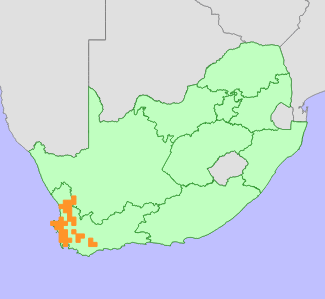|
Scientific Name | Helichrysum stellatum (L.) Less. |
Higher Classification | Dicotyledons |
Family | ASTERACEAE |
Synonyms | Gnaphalium stellatum L. |
National Status |
Status and Criteria | Least Concern |
Assessment Date | 2020/02/20 |
Assessor(s) | L. von Staden |
Justification | Helichrysum stellatum is a widespread and common species, with an extent of occurrence (EOO) of 43 059 km². It is declining in parts of its range due to ongoing habitat loss and degradation, but is not yet in danger of extinction, and is therefore listed as Least Concern. |
Distribution |
Endemism | South African endemic |
Provincial distribution | Northern Cape, Western Cape |
Range | This species is endemic to South Africa, and is found from the Bokkeveld Escarpment in the Northern Cape to Worcester and the Cape Peninsula, eastwards to Montagu and Swellendam in the Western Cape. |
Habitat and Ecology |
Major system | Terrestrial |
Major habitats | Saldanha Flats Strandveld, Bokkeveld Sandstone Fynbos, Swartland Granite Renosterveld, Graafwater Sandstone Fynbos, Leipoldtville Sand Fynbos, Atlantis Sand Fynbos, Hopefield Sand Fynbos, Kobee Succulent Shrubland, Swellendam Silcrete Fynbos, Swartland Alluvium Fynbos, North Langeberg Sandstone Fynbos, Breede Sand Fynbos, Breede Alluvium Fynbos, Boland Granite Fynbos, Peninsula Granite Fynbos, Breede Quartzite Fynbos, Namaqualand Riviere, North Sonderend Sandstone Fynbos, Cape Flats Sand Fynbos, Lambert's Bay Strandveld, Namaqualand Strandveld, Klawer Sandy Shrubland, Citrusdal Vygieveld, Vanrhynsdorp Gannabosveld, Cape Flats Dune Strandveld, Langebaan Dune Strandveld, South Langeberg Sandstone Fynbos, Saldanha Granite Strandveld, Cape Lowland Alluvial Vegetation, Swartland Alluvium Renosterveld, Piketberg Sandstone Fynbos, Winterhoek Sandstone Fynbos, Nardouw Sandstone Fynbos, Doringrivier Quartzite Karoo, Olifants Sandstone Fynbos, Saldanha Limestone Strandveld |
Description | It occurs on sandy flats and lower slopes in fynbos. |
Threats |
| At least 45% of this species' habitat is irreversibly modified, mainly on the coastal lowlands, where there has been extensive loss to urban and agricultural expansion. Loss continues, particularly in small, isolated remnants, where there is ongoing degradation due to alien invasive plants, inappropriate fire management and overgrazing. |
Population |
There is no information available on the population of this species.
|
Population trend | Decreasing |
Assessment History |
Taxon assessed |
Status and Criteria |
Citation/Red List version | | Helichrysum stellatum (L.) Less. | Least Concern | Raimondo et al. (2009) | |
Bibliography |
Goldblatt, P. and Manning, J.C. 2000. Cape Plants: A conspectus of the Cape Flora of South Africa. Strelitzia 9. National Botanical Institute, Cape Town.
Hilliard, O.M. 1983. Gnaphaliinae (First Part). In: O.A. Leistner (ed). Flora of Southern Africa 33 Asteraceae, Part 7 Inuleae, Fascicle 2:1-325. National Botanical Institute, Pretoria.
Raimondo, D., von Staden, L., Foden, W., Victor, J.E., Helme, N.A., Turner, R.C., Kamundi, D.A. and Manyama, P.A. 2009. Red List of South African Plants. Strelitzia 25. South African National Biodiversity Institute, Pretoria.
|
Citation |
| von Staden, L. 2020. Helichrysum stellatum (L.) Less. National Assessment: Red List of South African Plants version 2024.1. Accessed on 2025/12/10 |
 Comment on this assessment
Comment on this assessment


